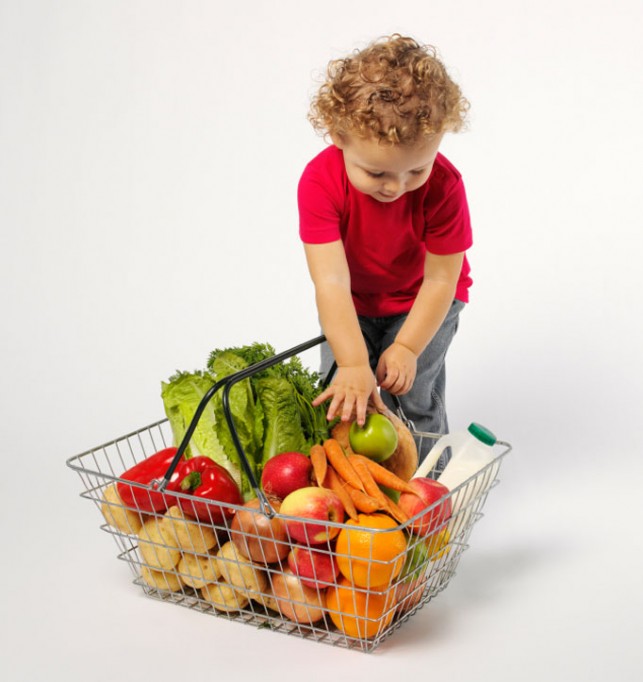Is a Vegetarian Diet Safe for My Child?

Earlier this month, health food blogger, Clarie O’Bryan shared her tips on how to jump start healthy eating habits with children. Today, Claire chats with us about how to ensure a vegetarian diet is providing the adequate nutrients for a child’s growing body.
What is a parent’s number one concern when making decisions for their child? Safety. We want to make sure the choices we make are, if nothing else, safe. Is a vegetarian or even vegan diet safe for your child? The short answer is YES. Does it require a little more effort and proper planning? YES. Below you will find tips adapted from evidence-based information from a popular clinician’s resource called UptoDate. These tips should reassure you that the vegetarian diet is safe and can be done. In this post, we will talk about protein specifically, as this is one of the most important nutrients to ensure proper development in your child.
How much protein does my child need?
Approximately half of their weight, in grams. If your child weighs 50 pounds, they need around 25 grams of protein per day.
Is all protein created equal?
No. Not all protein is the same. Proteins are made of amino acids, and there are essential amino acids that humans require for growth and development. Foods containing all essential amino acids are called “complete proteins.” Complete proteins are found readily in meat and dairy products. Most plants do not contain complete proteins, which is why vegetarian or vegan diets require more planning. Some vegetarian items together (like rice and beans) will complement each other to create a complete protein.
How do vegetarians get complete proteins?
All plants and grains contain some of the essential amino acids, so by eating a wide variety of fruits, vegetables, grains, nuts, seeds and beans (or legumes) complete proteins are made. There are plants and grains that contain complete proteins. Soy, seaweed, spirulina, buckwheat, hemp seed and quinoa all contain complete proteins. It is important to ensure your child eats a wide variety of foods in addition to foods known to have complete proteins. Any dairy product (eggs, milk, yogurt and cheese) will contain complete protein.
I consulted recently with pediatrician, Minor Vernon, MD, who has been practicing primary care pediatrics for more than 30 years. He noted, “Of course, the challenge with any vegetarian is adequate protein. I encourage any parent who wants to start their child on a vegetarian diet to make sure they are taking a multivitamin and drinking a minimum 8-12 ounces of milk or soy milk daily. This is a non-negotiable, and as they age, this amount should increase.”
UptoDate’s stance on children eating vegetarian or vegan diets is summarized as:
“Children fed vegetarian diets that also include animal flesh, milk, milk products, or eggs generally consume more than enough complete protein to meet their needs as long as energy [caloric] intake is sufficient [52]. Meat and fish are good sources of protein for children who consume semi-vegetarian or macrobiotic diets. Non-meat foods high in protein include soy products (e.g., tofu and soy milk), milk, other dairy products, and eggs. Foods such as legumes, grains, cereals, potatoes, and pasta also contribute to protein intake but to a lesser degree. If vegan children eat a variety of plant foods and meet caloric needs, their protein intake is usually adequate.”
Chocolate Peanut Butter Protein Milkshake
Prep Time: 5 minutes
Yields: One 12 ounce shake or two 6 ounce shakes
Ingredients:
1 cup of Soy or Cow’s milk (chocolate, plain or vanilla)
1-2 scoops Chocolate protein powder
1 heaping TBSP of Peanut Butter (organic, of course!)
1 small banana (fresh or frozen)
1 heaping handful of spinach (fresh or frozen)
Directions:
Blend all ingredients together in a blender until smooth or will also fit in a Magic Bullet (LINK). You may want to add more or less milk, basing on your preference to thickness. Depending on the particular ingredients you use, this recipe batch yields approximately 30-35 grams of protein and about 350 calories (again, depends on what products and brands you use). And, I promise, your kids won’t even realize the spinach is there!
SHARED By: Claire O’Bryan, APRN
Claire O’Bryan is a Nurse Practitioner at the Medical University of South Carolina, located in Charleston, SC. With an undergraduate degree in Exercise Science, Claire brings a basic foundation of nutrition and exercise, coupled with extensive knowledge of anatomy and physiology. She utilizes this unique skill-set in her daily patient work, while also sharing her expertise with readers online through her blog, HeavyontheVeggie.com. As a vegetarian and most-of-the-time vegan, Claire is committed to helping people realize the full potential of food – the good and the bad, the risks and the rewards. She currently resides in Charleston with her husband, Ed, and their dog, Beatrice.










Pingback: 15 Blogs for Learning about Vegetarian Diets for Kids : Living Green Magazine